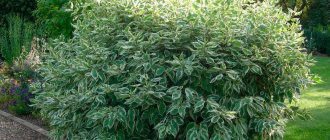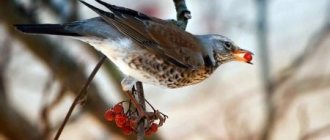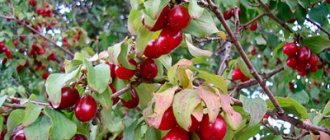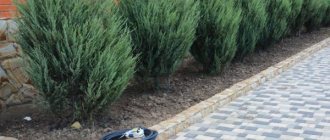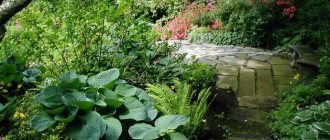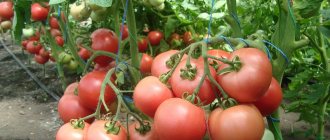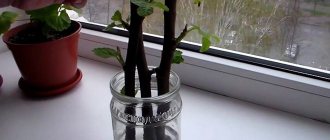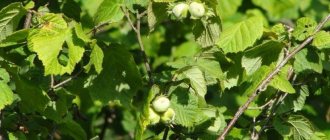In the last days of March, when winter still persistently holds its position: blizzards rage with heavy snowfalls, especially at night; The thermometer shows sub-zero temperatures, and then the dogwood blossoms - the first honey plant and pollen plant.
The earth has not yet been completely freed from snow, night frosts are frequent, sometimes it snows, and on sunny warm days bees with abundant light yellow pollen and crops full of nectar rush to the hives.
Freed from the load, they quickly fly out of it. Bee families become more active during this period. Bees and other pollinators visit flowering dogwood bushes very actively for 8 to 12 days.
Growing dogwood
Dogwood, dogwood - Cornus mas L. - a shrub, less often a tree, reaching 3–8 m in height, from the dogwood family.
It usually grows along the edges of forests and in forests, forming its undergrowth, as well as in river valleys. It is especially abundant on the limestones of the steep slopes of the Dniester, which indicates its drought resistance and undemandingness to soils. Dogwood is exceptionally good for creating hedges. In the wild, dogwood is distributed in the Caucasus, Crimea, and southwestern Ukraine.
Dogwood flowers are small, pale yellow, collected in sessile umbrellas, up to 30 pieces in each. The leaves are opposite, elliptical, wide. The fruits are juicy drupes; mature ones - dark red, cherry, crimson flowers. There are both white- and yellow-fruited cultivars. The length of the fruit is 2–3 cm and 1–1.5 cm in diameter. The fruits ripen slowly. They have a pleasant sourish-astringent taste. Cultivated varieties contain up to 9% sugar, 1.7–2.9% malic acid, vitamins, minerals and tannins. The latter are contained in leaves and bark. The fruits are used for jam, liqueurs, compotes, etc.
Looking at a dogwood bush in the fall, you can clearly imagine next year’s harvest, since the flowers are already laid and formed, but have not bloomed. In the spring, without noticeable swelling, dogwood begins to bloom in the first warm days, long before the leaves bloom.
Place and soil for growing dogwood
It is desirable that the soil in which the dogwood will grow is fertile and loose with a soil acidity level of pH 6.0-7.0. Choose a site for the plant that is well lit, but not in direct sunlight.
The planting pit is prepared in advance; for autumn planting, the pit is prepared in the summer, and for spring planting, in the fall:
- The distance between the pits is 5-6 m. It is better to maintain the same distance in relation to other plants and trees.
- To create a hedge from dogwood, maintain a distance of 3-4 m.
- Planting holes for dogwood are 70-80 cm deep and 80-100 cm wide.
- The dogwood seedling is placed in the center, the root system is straightened and sprinkled with earth.
- After planting, the plant is watered (2-3 buckets) and mulched with sawdust.
Dogwood care
Dogwood is a moisture-loving plant; in dry weather, this feature needs to be given increased attention. But it cannot tolerate waterlogging and swampiness. Irrigation by sprinkling or in a circular furrow.
Caring for dogwood will not be complete without weeding, but very carefully down to 10-15 cm in depth, since the root system of the plant is located in the top layer of soil, at a depth of only 40 cm.
Apply fertilizers: nitrogen-phosphorus in the spring, and potassium fertilizer (wood ash) in the fall. Moreover, determine the amount of fertilizing yourself; for a plant with rich green leaves and a healthy appearance, less fertilizing is required.
Mulch with sawdust, grass clippings or peat. Lime is added due to its high calcium content.
If you want to have a dogwood tree and not a bush, then in the first years of its life, start forming a trunk. Its height is 50-70 cm, all shoots appearing below are removed.
Dogwood pruning is carried out as necessary, in case of thickening or for rejuvenation in February-March. Non-fruit-bearing branches are also pruned before the growing season begins.
Depending on the variety and planting density, the timing of fruit ripening varies. The collection of ripe fruits begins at the end of August and continues throughout September and even at the beginning of October. Do not delay the collection of dogwoods, as the berries quickly begin to fall off, or birds will peck. Ripening can take place during storage without losing taste. Fresh fruits can be stored for up to 12 days in a plastic bag with holes in the refrigerator.
Dogwood propagates by seeds, cuttings, layering, suckers and grafting.
This process is very long and labor-intensive, since fruiting occurs only after 7-10 years. For seed propagation of dogwood in July, seeds are selected from green fruits and planted immediately in a permanent place. Next, monitor the condition of the soil, preventing it from drying out. Next spring you will see dogwood sprouting.
If the seeds are taken from ripe fruits, then they need to go through a stratification process: put the fruits in barrels and wait until they begin to ferment, then grind them, wash them, mix them with sawdust and leave them in them for 1.6 years (until spring). Plant in the ground.
Reproduction of dogwood by cuttings
Reproduction of dogwood by green cuttings: in June-July, green cuttings are taken from the middle of annual shoots and soaked for 5-6 hours in the root formation stimulator Heteroauxin. Dogwood cuttings are planted in the garden in loose soil in partial shade under plastic film, so that there is no contact with the cuttings.
Reproduction of dogwood by lignified cuttings: in the fall, cut cuttings in the southern regions are planted in a permanent place before winter, but in the northern regions they are stored in the refrigerator until spring. Before planting, soak for 24 hours in any root formation stimulator. After planting, monitor the soil moisture, preventing it from drying out.
The simplest method of vegetative propagation. In autumn, 1-2 year old shoots are bent to the ground and pinned, soil is poured on top with a layer of 10 cm, and watered regularly. Next year, separate it from the mother bush and plant it in a permanent place.
Dogwood propagation by grafting
Wild dogwood is propagated using the budding method. To do this, you will need well-developed rootstock seedlings in order to budding with a bud in August-September. Cut the bud of the rootstock with the petiole of the leaf, insert it into the T-shaped cut on the rootstock, wrap it with plastic tape so that the bud is visible. After 2-3 weeks, with a successful combination of circumstances, the leaf petiole falls off. In October the winding is removed. With further growth of the bud, the emerging shoots of the rootstock above it are cut off.
Category: Dogwood, Goji
Botanical description
Botanical illustration from the book Flora von Deutschland, Österreich und der Schweiz by
, 1885
Deciduous tree 5-6 m high or multi-stemmed shrub 3-4 m high. The root system is fibrous, mainly at a depth of 40 cm.
The branches are horizontally spread, with blackish bark. The leaves are opposite, simple, 3.5–8 cm long, oval, shiny, bright green, with three to five pairs of veins.
The flowers are small, golden yellow, bisexual, collected in umbellate inflorescences; there are 15-25 flowers in an umbrella. The flower is regular, bisexual, a barely noticeable calyx with four teeth, a yellow corolla with four petals, four stamens, an inferior bilocular ovary, a simple style, with a fleshy disc developed at its base [4]. It blooms before the leaves bloom in April at a temperature of 8-12 °C, flowering lasts for 10-14 days.
The fruit is a juicy drupe, the stone is elongated-oval. Dogwood fruits have different shapes and sizes. They are short and long oval, spherical and pear-shaped. The surface of the fruit is smooth, lumpy, slightly lumpy; the color is light red, red, dark red, dark purple and almost black. The average weight of the fruit is 2-6 g. The weight of 100 fruits including seeds varies depending on their size and shape - from 190 to 400 g. The weight of the pulp of the weight of the fruit ranges from 68 to 88%. The fruits ripen at the end of August - September.
Reproduction, grafting and cuttings of dogwood.
Dogwood is propagated by seeds and vegetatively, but the seed progeny does not imitate all the economically valuable characteristics of the variety that is propagated. In addition, these plants enter the fruiting phase late (at 6-8 years), and vegetatively propagated at 3-4 years.
Dogwood is propagated vegetatively by grafting (budding), transplanting, and cuttings. Dogwood plants grown from seeds have larger root systems than those propagated vegetatively, especially those grown from shoots. In dogwood seedlings, the roots are deeper and develop more rapidly, differing in the direction of intense physiological growth. Dogwood plants grown from shoots grow more slowly throughout the growing season and are lower than seedlings.
Dogwood fruits
The dogwood fruit is a juicy drupe. Wild dogwood has elliptical or cylindrical fruits. The photo above is him. Bottle-shaped, pear-shaped and oval fruits are also found in domesticated plants.
The color of the dogwood fruit can be pale, slightly reddish, or almost black. There are also dogwood varieties whose berries are yellow and pink.
https://www.youtube.com/watch?v=psOecVgY5JY
Inside the fruit there is an oval-shaped stone. The length of the seed is about one to one and a half cm. A seed can contain from one to three seeds.
Dogwood propagation.
In order for a seed to germinate, it must be stratified (20-28 months). It is better to sow freshly collected seeds (without drying) or with fruit (pulp) immediately after removing the fruit from the tree (in August - September). Friendly (70-85%) seedlings hatch 18 months after planting. Under favorable conditions, dogwood seeds can be harvested in small quantities (11-20%) next spring.
A good way to prepare dogwood seeds for planting is to keep them in damp moss for about a year with constant moistening and stirring. To do this, in April, in a shaded place (under a tree, a canopy), boxes with dogwood seeds embedded in moss are placed in holes 40-50 cm deep. The boxes are covered with film, the seeds must always be moistened and mixed. Water as standard, depending on the weather, once every 3-5 days. Cover with earth for the winter. In April, the boxes are opened and the sprouted seeds are sown.
Reproduction of dogwood by layering.
To do this, dogwood mother plants are given the shape of a bush. Young shoots in the period from 1 to 3 years are bent down and placed in specially dug grooves 15-20 cm deep. The lower part of the groove is loosened. The shoot is secured with wooden pins, its top is tied to a vertical support peg. When laying shoots, it is necessary to trim the bark under the puff node in the place where the shoot bends upward. This causes roots to grow and multiply. On poor lands, the ditch is filled with fertile soil, which is well compacted.
Jiggings are placed before the buds swell (turn on) - in March, April, but it is possible later, even in the fall. The deposits are well watered and fed during the growing season. The soil is loosened and weeds are destroyed. Dogwood seedlings with a well-formed root system are dug up and planted in a nursery or in a permanent place.
Dogwood grafting.
Dogwood grafting (budding) is one of the most common and good options for dogwood propagation. It is carried out at the end of July - beginning of August, during the period of slight lag of the bark on the rootstocks.
Dogwood seedlings from seeds of cultivated forms and varieties or wild ones are used as a rootstock. Until the end of the growth period, the oculants grow to a height of 70-80 cm; they are very different from wild dogwood plants - the leaves are rounded, large - often several times wider and longer than those of seedlings.
In the first year, budded plants grow from 3 to 5 versatile shoots and by autumn they can be planted in a stationary place. At 2 years of age they are up to 80–140 cm high, well branched. In the third year they begin to bear fruit.
Dogwood cuttings.
It is best to propagate dogwoods from green cuttings in a misty setting. To do this, shoots are taken in a phase of strong growth, with a well-developed growing point and weak lignification in the lower part of the stem. Cuttings 10-15 cm long with 2 pairs of leaves are cut in the morning and immediately placed in water.
Before treating with growth substances, a sharp pruner or blade is used to make an oblique cut at the end of the shoot, 0.5-1 cm below the bud. For better root growth, shoots are treated with 0.02-0.03% heteroauxin solution or 0.001% indolylbutyric acid for 20 to 24 hours.
After 40-50 days in dogwood cuttings that have succumbed to the action of growth stimulants, and after 55-60 days in untreated ones, general growth begins and the formation of new roots begins. Cuttings that have already begun to take root well are planted for growing in a nursery, and after a year (in the fall) or a year and a half (in the spring) - in a permanent place. Berries.
Dogwood reproduces well by seeds (in autumn, after collecting seeds or in spring after stratification), root suckers (spring and autumn), dividing the bush (when transplanting), grafting on dogwood (during sap flow), less often - green cuttings (in summer) .
Reproduction of dogwood by seeds.
To propagate dogwood by seeds, seeds are harvested in the fall. They are mixed with wet sawdust and placed on stratification. Stratification lasts more than a year - dogwood seeds are sown not next spring, but a year later (then the seeds germinate in the year of sowing). If you sow immediately with dry seeds, seedlings are also obtained after two years, but more uneven and sparse.
The usual care for sowing seeds is carried out: watering, fertilizing, weeding; in the south, shading is necessary. The seedlings are small, grow slowly, and by the end of the first year of vegetation they grow by 3-5 cm. At the end of the second year of growing season, the seedlings reach a length of 10-15 cm. During this period, they are transplanted to a separate area for growing.
Reproduction of dogwood by root suckers.
To propagate dogwood by root suckers, use root shoots, which grow annually around the bush.
Young offspring are separated from the mother bush and transplanted to a permanent place both in spring and autumn.
Reproduction of dogwood by grafting.
When dogwood is propagated by grafting, two-year-old dogwood seedlings are used as a rootstock. The grafting is carried out in the spring, during the period of sap flow, at a height of approximately 10–15 cm. If they want to get a standard form, then the grafting is done at a height of 75–80 cm.
The grafting is carried out into the root apex (“root collar”) or into the seedling bole. Using a sharp knife, cut the rootstock horizontally. Then, in the middle of this cut, a vertical cut (or split) about 3 cm deep is made.
An oblique cut is made with a sharp knife above the upper bud of the cutting, and a horizontal cut is made about 15 cm below. A wedge is formed from the lower end of the cutting with two oblique cuts about 4 cm long: one of them starts near the bud, the other on the opposite side.
The scion is carefully, but also with some effort, inserted into the split on the rootstock. Part of the scion cut remains outside. This kind of “window” will contribute to the development of callus.
The junction of the rootstock and scion is tightly tied with transparent polyethylene tape. To reduce evaporation, the top of the scion is coated with garden pitch.
The grafted plants are buried in a box with a mixture of sand and peat so that the connection point is just above the surface of the substrate. The box is placed in a cold greenhouse, a closed chamber or on a rack in a greenhouse. The higher the temperature, the faster the parts of the graft will grow together. But it is necessary to ensure that they do not dry out.
When the grafting components grow together, callus will begin to form on the exposed parts of the cuts. This can be observed in the “window” directly above the cut of the rootstock. The callus formed here increases the strength of the joint.
After the grafting has grown together, the polyethylene tape is cut and removed. The grafted dogwood is planted in open ground. The shoots formed on the rootstock are cut out.
Reproduction of dogwood by layering.
To propagate dogwood by horizontal and arcuate layering, it is better to take well-developed annual shoots or biennial branches with strong growth on young bushes. Layering is best done in early spring, as soon as the soil allows. The soil under the bushes intended for layering must be well dug up in advance, mixed with fertilizers and leveled.
After this, shallow grooves are made in the soil from the base of the bush, into which young shoots are bent and pinned. The tops of the latter are lightly pinched. When 10-12-centimeter young green shoots develop from the buds of the branched branches, they are sprinkled halfway with moist fertile soil or humus. After 15-20 days, when the shoots have grown another 10-15 cm, the powder is repeated.
Rooted cuttings can be separated from the mother bush and transplanted to a permanent place either in the fall or next spring. It is preferable to separate the cuttings next spring.
Reproduction of dogwood by cuttings.
Dogwood propagation by green cuttings is carried out less frequently, due to the low percentage of rooting (40-60%).
For cutting cuttings, choose powerful healthy bushes, at least 5-6 years old. Cuttings are cut in the first half of summer, from the tops of all branches of the bush.
The length of the cutting should be 10-15 cm. After cutting, the cuttings are prepared for planting: the lower leaves are removed, leaving 2-3 upper ones.
Before planting, for better rooting, the lower ends of the cuttings are immersed in a solution of a rooting agent (growth stimulator) for 6-12 hours. Then the cuttings, washed in clean water, are planted in pre-prepared cold greenhouses.
Cold greenhouses for green cuttings are prepared in advance (in June). Coarse, sifted, well-washed sand in a layer of 7-10 cm is poured onto the dug up clean layer of soil in greenhouses before planting the cuttings.
The cuttings should be planted obliquely, almost close to each other. There should be a free space of 15-20 cm high between the greenhouse film and the cuttings. After planting, the cuttings are carefully and abundantly watered from a watering can with a very fine strainer. It is very important that the water does not flow in a continuous stream, but splashes. After watering, the greenhouse is covered with film.
The main care for cuttings consists of regular watering (at first it is important that the air in the greenhouses is warm and humid) and ventilation of the greenhouses when the temperature in them rises above 25°.
Rooted two-year-old dogwood cuttings Two or three weeks after planting, cuttings in greenhouses take root well. After this, the film is opened slightly during the day, and then, when the cuttings have undergone some hardening, the greenhouse is left open overnight. 7-10 days after rooting of the cuttings, the film is removed altogether.
Three-week-old cuttings, with proper care, form a good fibrous root system.
Rooted green cuttings are planted for growing in a separate area. As soon as the seedlings take root, they are liquid fed with nitrogen mineral fertilizers (30 g of ammonium nitrate per bucket of water) or slurry diluted with water 6-8 times.
During the summer, the soil is loosened and weeded, and in dry weather the soil is watered abundantly.
Next autumn the bushes are transplanted to a permanent place.
Reproduction of dogwood by dividing the bush.
Reproduction by dividing a bush is used mainly when transplanting a bush from an old site to a new location.
To do this, dig up the bushes (in the spring before the buds swell or in the fall a month before the onset of frost), cut out all the old branches, leaving young, vigorous ones, shake off the soil from the roots and cut the bush into several parts, depending on its size.
When dividing a bush, you must ensure that each new part of the plant has a well-developed root system and a healthy above-ground part (1-2 shoots). Each part should have good, young, well-developed roots; old roots are removed and the rest trimmed.
There are several ways to propagate dogwood: by seeds, layering, dividing the bush, root suckers, and grafting. If you follow all the rules and a clear sequence of actions, any method will bring excellent results. First, you should study the details of each method and choose a more acceptable option for yourself.
Planting dogwood in open ground
Timing
In central Russia, dogwood can be planted either in spring or autumn. In the first case, we are talking about the end of March or the beginning of April. If you decide to plant this plant in the fall, this will need to be done before the first frost. It will be necessary to land it no later than three weeks before their onset.
If you do this, the seedlings will take root well, overwinter and sprout in the spring.
Site selection and soil preparation
How to find the most convenient place for this plant in your garden? First of all, we must not forget that dogwood trees must be pollinated. The most optimal distance for this is from five to six meters. The distance to other plants should not be less than five meters.
When growing dogwood, you need to remember that the plant is an unpretentious plant; places where there is plenty of sunlight and those that are slightly shaded are suitable for it. In this case, it is necessary that such a place is protected from the wind. In relation to the soil, the plant is quite unpretentious.
In central Russia, almost any soil is good for it. But dogwood does not tolerate it if it is wet and swampy. Particularly good growing conditions for this plant are good sunlight and calcareous, acidified and well-drained soil. Both high and low areas are good for growing.
If you want to plant a dogwood tree in a small summer cottage, it will be convenient to plant it close to the edge. After all, this plant is very durable and can live up to two hundred years.
Soil treatment and preparation
Let's not forget that well-prepared soil will allow you to get a rich harvest. What needs to be done for this? It is advisable to start this at least six months before planting.
First you need to dig up the soil where you are going to plant dogwood.
This needs to be done to a depth of 60 to 80 centimeters. Then it is important to remove all perennial weeds (dandelion, wheatgrass and others) from this area.
The soil needs to be fertilized. Manure is good for this, if you take five kilograms per square meter. If the soil is too acidic, it must be limed.
At the next stage of preparation, you need to prepare the holes for the seedlings
They need to be made at a depth of 50 and a width of 60 centimeters. These parameters apply if the soil is prepared for planting seedlings. If this was not done, then the dimensions of the holes should be slightly larger. In this case, take a depth of 70 and a width of 90 centimeters.
We fill the dug holes with fertile soil, add the fertilizers and humus necessary for the seedlings. You can use two buckets of humus per seedling and you need to add the necessary phosphorus, nitrogen and potassium fertilizers. The latter must be poured into the bottom of the hole in such a way as to avoid their direct contact with the dogwood roots.
The process of planting in open ground
For planting, two-year-old seedlings approximately one and a half meters high are usually selected. They try to select a seedling so that its trunk is about two centimeters thick and has five skeletal branches.
When planting, they are usually cut back to a third of their length. Some gardeners believe that pruning is unnecessary. Planting trees individually is not recommended. Usually the minimum number of seedlings is two or three. This is necessary in order to ensure pollination of these plants.
To stabilize the seedling, a peg is driven in to which it will need to be attached. The peg is placed on the side from which the wind usually blows. The seedling is dug in so that the root collar is approximately three centimeters above the soil. This is necessary so that when the earth settles, it will be level with the surface of the earth.
How to propagate dogwood by cuttings
This method involves propagating dogwood using green cuttings. It is produced in the summer after the growth of annual shoots has stopped. You should choose a healthy adult shrub that is at least five years old for cuttings.
The shoot is separated in the morning. From the branch you like, cut off the upper part of the shoot, 10-15 cm long. Using a sharp knife, make an oblique cut 1 cm below the last bud. Then, using pruning shears, you will need to remove all the leaves except the top 2-3.
The finished cutting should be placed for several hours in a pre-prepared solution, which is a growth stimulator. After the time has passed, rinse the workpiece with cold water and plant it in a greenhouse.
If a lot of cuttings are planted, then arrange them densely. Approximately every 3-4 cm. It is necessary to water the soil well. After planting, sprinkle the soil with pre-washed coarse sand. Its layer should be about 10 cm.
At the end of the work, you need to cover everything with film. A distance of approximately 20 cm should be left from the tops of the cuttings to the ceiling of the greenhouse. Greenhouse conditions require maintaining a humid climate with a temperature of about 25°C. In the future, do not forget about mandatory ventilation and periodic watering.
The root will form in two months. It is possible to reduce the rooting period when using certain types of stimulants.
The formed root system signals the arrival of the time for hardening of seedlings. You should start by briefly removing the film on the greenhouse, gradually increasing the time every day. It is necessary to calculate the period so that on the tenth, perhaps twelfth day, the mini-greenhouse is completely removed.
Later, you can plant young dogwood seedlings. When adaptation to a new place takes place, it is advisable to feed it with organic and nitrogen fertilizers. After a year, they are transplanted to a permanent place where the shrub grows. Both spring and autumn are suitable for such work.
This method is characterized by a low growth rate of seedlings. But it is quite suitable if it suits the gardener or there is no need for a large production volume of cultivation.
How to grow dogwood from a seed
The technology for propagating dogwood seeds is quite lengthy and labor-intensive. It begins in autumn, after harvesting the fruits. To begin with, the pit should be carefully cleared of pulp. Then it is placed in a humid environment (for example, in sawdust or moss), where it remains for a whole year. All this time it is necessary to ensure that the moss does not dry out. In this way, the natural conditions in which the seed overwinters are imitated, which is necessary to increase the reliability and speed of its subsequent germination (the so-called stratification). You can plant the seed directly in the ground, in which case it will sprout in the second year (you won’t be able to save time), but germination will be much worse.
Did you know?
The seeds of not fully ripened fruits sprout faster than ripe ones - in just six months. In addition, seeds taken from freshly picked berries show better germination than pre-dried ones.
The prepared seed is immersed in the ground to a depth of approximately 3 cm. After the first dogwood shoots appear, they need to be protected from direct sunlight, watered and fed as needed. In the autumn of the second year after planting (the shoots by this time have grown to 10-15 cm), the dogwood is ready to be planted in open ground, but the shrub will produce its first fruits only after a few years (from seven to ten). Thus, it takes a lot of time to propagate dogwood from a seed: 14 years can pass from the start of seed preparation to harvesting.
Did you know?
There is an express method for growing dogwood from a seed.
Fresh seeds are placed in a two percent sulfuric acid solution for three days, then placed in a container filled with wet sand for the winter, and planted the following spring. To propagate dogwood from seed, wild species of shrubs are used, after which selected dogwood is grafted onto the grown seedlings.
Dogwood propagation by green cuttings should be carried out in the summer and only when the growth of young shoots stops.
Cuttings must be taken from an adult (at least 5 years old) healthy bush.
From any branch in the morning, the top 10-15 cm long is cut off, from which all leaves except the top two or three are removed with pruning shears, and an oblique cut is made at the end of the shoot 5-10 mm below the bud. The cuttings prepared in this way are placed in a growth stimulator for several hours, washed with cold water and planted in a greenhouse prepared in advance; the loosened soil is covered with a thick (up to 10 cm) layer of coarse sand, previously sifted and washed.
The cuttings are planted very densely, at a distance of 3-4 cm from each other. The distance to the top of the greenhouse from the top of the cutting should be 15-20 cm. Next, the cuttings are watered and covered with film.
Important!
Watering newly planted cuttings should not be done with a direct stream of water.
Use a watering can with a fine strainer or other device that provides gentle spraying! The air in the greenhouse should be moist and warm enough, but not higher than 25 ° C; if necessary, the greenhouse should be ventilated. Cuttings also need constant watering. With proper care, the root system of cuttings is formed in one and a half to two months
(depending on whether they were previously subjected to a growth stimulation procedure). At this time, you can begin to harden the cuttings: the film is removed from the greenhouse first for a short time, gradually increasing it so that by the tenth day the film is completely removed.
Subsequently, the sprouted cuttings are transplanted into a nursery, allowed to take root, and then fed with nitrogen fertilizers or organic matter (manure). The next year (spring or autumn), the seedlings can be transplanted to a place designated for an adult bush.
The method of propagating dogwood by cuttings is not very popular due to the low growth rate.
Reproduction of dogwood by seeds
This method is no less time-consuming, labor-intensive and painstaking. To propagate dogwood from seeds, the fruits are harvested in the fall, after removing the pulp from the grain. Next, for a whole year, the seeds are placed in a humid environment with moss or sawdust. Of course, you need to regularly water the substrate to prevent it from drying out. This is how stratification occurs, which is necessary for the speedy growth and hardening of seeds.
Another method of this growing method involves planting freshly collected seeds in the fall directly into open ground. Chrysanthemums are propagated by seeds using the same principle. Germination of dogwood will also occur in a year. But in this case, germination may be significantly worse due to the unpredictability of natural conditions.
Seeds collected from unripe fruits have better germination.
Dogwood seeds go 3-5 cm deep into the soil. When the first shoots appear, they should be fed and watered as necessary. It is also necessary to protect the sprouts from direct sunlight to avoid burns of the foliage and rapid drying out of the soil.
In the fall, in a year, the seedlings will be up to 15 cm high. They can already be transplanted to a new place of growth.
The first fruits will appear only after 7-10 years.
Grafting dogwood with cuttings
This method is called budding. It is most preferred among gardeners in the propagation of dogwood and other types of fruit bushes and trees. The big advantage of grafting is that it can be done both in the spring, during the period of sap movement, and in mid-summer, when the bark is well peeled.
Dogwood grafting with cuttings is carried out mainly on wild species due to their greater adaptation to various natural factors and survival in the natural environment.
The suitable height for grafting on wild dogwood is 10-15 cm. If standard forms are used, it is 75-80 cm.
The rootstock, that is, the place where the graft will be inserted, is cut evenly. A recess is formed in the middle part. The scion is the top cutting. It should have a total length of about 15 cm.
Prepared like this:
- The future upper part is cut off above the bud with an oblique cut. It must be treated with garden varnish.
- The lower part should have a wedge-shaped cut 4 cm long. This is done using two oblique sections with a sharp, disinfected object.
For dogwood grafting, two-year-old seedlings are used.
During the grafting process, the scion wedge is carefully inserted into the recess so that part of the cut remains outside. The joint is wrapped with transparent material to support the structure. The bush itself is sprinkled with a mixture of peat and sand to the grafting site.
After this procedure, the dogwood should be placed in greenhouse conditions, where the two parts will grow together faster. This requires elevated temperature. Successful fusion can be determined by the appearance of new tissue - callus - at the grafting site. This means that it is time to transplant the dogwood into open ground and remove the winding.
Next, you will only need to ensure that the shoots that emerge from the rootstock are trimmed in time. This procedure is necessary to avoid the formation of fruits on the wild growing part of the dogwood.
Dogwood care
Growing conditions in the garden
Planting and caring for dogwood is not much different from planting and caring for any other fruit shrub - rose hips or barberry, for example. Caring for dogwood consists of watering, loosening the soil on the site, removing weeds from it, pruning the shoots of the plant and fertilizing.
The peculiarity of dogwood is that there is no periodicity in its fruiting, that is, it produces a harvest annually. The planting of the next year's crop is carried out in May-June of the current year, and before the end of the growing season, the flower buds that form simultaneously with the growth of shoots must be completely formed. This is why it is so important to water and fertilize dogwood in a timely manner. To ensure that water does not spread over the area, but is directed to the superficial root system, make a circular furrow around the bush and pour water into it.
Try to maintain a balance in hydrating the dogwood: there should be enough water, but excessive watering is unacceptable. After watering, the soil in the area is loosened no deeper than 8-10 cm, while getting rid of weeds. As for fertilizing, in the first half of the season they use fertilizers with a nitrogen-phosphorus component, and in the second they focus on potassium - for example, they add wood ash to the soil. Dogwood responds well to compost and humus, but the most important thing for dogwood growth and fruiting is the presence of calcium in the soil - keep this in mind.
Trimming
Growing dogwood requires regular pruning of the bush. In winter or early spring, during the dormant period, remove from the bush all damaged, dry and frostbitten branches that are easy prey for fungi or harmful insects. Before cutting a branch, dip the scissors in a 1:3 bleach solution to avoid transferring pathogens that may have settled on the dogwood to healthy branches.
Shorten or prune stems that are too old to the ground to encourage new growth. Cut out branches and shoots growing inside the bush. If your bush is grafted, remove all shoots below the grafting site. You most likely will not have to do formative pruning, since the plant has a natural, beautiful crown.
Pests and diseases
As a rule, dogwood is not affected by pests or diseases. But sometimes, extremely rarely, the plant suffers from the fungal disease rust, which appears as yellow spots on the leaves. The fungus is destroyed by treating the plant with Bordeaux mixture. Dogwood is also rarely affected by powdery mildew, which is combated with colloidal sulfur, as well as spotting, against which dogwood is treated with the same Bordeaux mixture. Among the pests that can disturb the dogwood are the cochlear scale insect and the multicolored caterpillar - the first is destroyed by treating the plant with lime, and the second with Parisian greens.
Features of care in the Moscow region
For some reason, it is common to think that dogwood does not take root in Moscow and the Moscow region, but this is not true. Breeders have developed varieties of plants that can withstand thirty-degree frosts, so dogwood develops normally and bears fruit abundantly even in the middle zone. Planting and caring for dogwood in the Moscow region is no different from growing the plant, for example, in the Stavropol region or in Ukraine.
Sometimes, however, the ends of its young shoots freeze over in winter, so they have to be cut off in the spring. To avoid such unpleasant surprises, young dogwoods should be covered with burlap for the winter for several years, and the tree trunks of dogwoods, both young and adult, should be mulched for the winter with a thick layer of peat or humus.
Reproduction by layering
The easiest way to obtain a new plant is vegetative propagation. This method involves sprinkling soil on individual branches from the selected bush. After this procedure, the shoots take root and new dogwood seedlings will emerge from them.
It is necessary to select annual shoots or branches that are two years old from the bush in the fall or early spring. Having tilted and slightly pressed them to the previously dug up soil, secure them with pins near the surface of the soil. The entire part of the shoot, except the top, should be sprinkled with soil. It must be pinned and, slightly lifted, secured to a vertical support. Regular watering is required.
Preliminary fertilizing of the soil will ensure the speedy appearance of buds and new shoots. Already in the spring of the next year, young dogwood seedlings are separated from the old bush and transplanted to a new place.
This quick method of propagation is used if it is necessary to transplant a large mature plant to another location. One bush is divided into many new seedlings.
Reproduction by division can be carried out twice a year:
- before the buds ripen in early spring;
- late autumn.
Having taken the plant out of the ground, it is cleared of dry branches. The soil is carefully removed from the rhizome and the bush is divided into several parts. Each new specimen ready for planting must have a stem and root. Having trimmed the rhizome, each part of the dogwood bush is transplanted to its own separate, specially prepared place.
Any of the described methods is accessible and not difficult to perform. The main thing is to follow the rules when observing temperature conditions, watering and choosing the right place to plant a new bush. Then, after a certain time, you can get an excellent harvest of very healthy dogwood berries.
Interesting information about dogwood and its cultivation - video
«>
Dividing a dogwood bush
If a dogwood bush needs to be transplanted from one place to another, propagation by dividing the bush is used.
During the year, this method can be carried out twice: either in early spring, before the buds swell, or, conversely, in late autumn. The bush is removed from the ground and cleared of old branches. The root is freed from the ground and cut into several parts (each should have both a root and an upper part). The root is trimmed, old shoots are removed, after which it is planted in a prepared place.
Dogwood propagation methods
In botany, there are only two generally accepted methods of plant propagation, the so-called sexual and vegetative. In the first case, to obtain new specimens of the species, derivatives of pollination are used, which contain the common genetic material of the maternal forms (seeds). The second is based on growing daughter plants that genetically replicate the original bush (rooting parts of shoots).
Seed germination is one of the most complex and labor-intensive processes of dogwood propagation. This is due to the fact that such biological material has low viability, so seed sprouts appear only under the most favorable conditions. At the same time, dogwood seedlings grow rather slowly and begin to bear fruit no earlier than 7 years after germination. That is why only breeders decide to grow shrubs using this method when breeding a new variety.
However, due to the lack of planting material, gardeners often decide to germinate seeds. For this, several green fruits are selected, devoid of any pathological changes and damage by infections and pests. Seeds are carefully selected from each berry, and then immediately sown in the ground in a permanent place. Before wintering, seedlings are provided with moderate watering and protection from weeds. The first shoots of such seeds appear no earlier than the spring of next year.
Did you know? Dogwood is one of the oldest fruit shrubs used by humans. Its beneficial properties were adopted about 5 thousand years ago. You can also take ripe seeds for sowing, but you need to stratify them. The procedure involves damaging the dense skin of the seeds, which increases not only their germination, but also their growth energy. To perform the procedure, you should place small wood shavings in a small container, and then place the seeds in it at a depth of about 1–2 cm. Next, the container should be well watered and placed in a moderately lit place.
Video: Reproduction of dogwood from a seed
Maintaining high humidity, the seeds germinate for about 12 months, after which the young shoots need to be planted in separate containers with well-fertilized sandy loam soil. In such conditions, the plants should be kept for at least 1–2 years; as soon as the seedling lengthens to 10–15 cm, it can be successfully transplanted into the garden bed. The procedure is carried out around the end of April, and a distance between neighboring plants should be at least 20 cm.
Propagation by cuttings
Dogwood cuttings are carried out in two ways: with green or woody parts of the bush. The green cuttings are selected approximately in the first half of summer; they serve as the central part of annual shoots, about 10–20 cm long. A third of the foliage should be removed from the resulting fragments, after which the prepared material should be soaked in a solution of any growth stimulant (for example, the drug “Heteroauxin”) for 5–6 hours. Next, each seedling is planted in partial shade in loose and well-fertilized soil (about 5–6 kg of humus/1 m² should be added to the soil), ensuring moderate humidity.
Lignified parts of the bush are selected in late autumn, several weeks before preparing for wintering. The middle part of young shoots no more than 3–4 years old, abundantly covered with foliage (15–20 cm long), is suitable for this. Planting material is planted in the soil around mid-April; until this time it is stored in the refrigerator at a temperature of +5...+10°C.
Before planting, damaged and wilted foliage is removed from cuttings and then soaked in a solution of any growth stimulant for 5–6 hours. Lignified cuttings are planted in well-fertilized and loose soil; with moderate watering throughout the season, they will successfully take root by wintering.
Important! Only mature bushes, at least 7–10 years old, free from traces of damage by insect pests or specific infections, are suitable for taking cuttings.
Reproduction by grafting
Grafting (budding) is ideal for growing dogwood in those areas where this shrub occurs wild and often becomes a weed crop. In order to improve such a bush, it is enough to plant just a small fragment of the fruit species. This procedure is performed around August-the first half of September; spring grafting is considered ineffective.
The basic technology for budding has identical steps as grafting any fruit tree or shrub:
- A small fragment of the shoot should be cut from the scion along with a viable leaf bud (the main cut should be as smooth as possible). At the same time, for the procedure to be successful, at least 2–3 kidneys should be grafted.
- On the rootstock (wild shrub), you should select the healthiest young branch no more than 3 years old, and then create a small T-shaped cut on it approximately in the middle. This is done so that the lignified bark can be separated, leaving the core intact.
- After this, you need to carefully separate the bark from the wood with a stationery knife, and place the scion with a bud into the resulting “pocket” and secure the grafting site with adhesive tape.
- If the process goes well, the kidney retains its viability and does not wither. After this, after about 3 weeks, the adhesive tape must be removed.
- In the spring, a young shoot will begin to grow from the rootstock; it should gradually be cultivated, and all nearby ones should be removed. Thus, a central branch should form from the grafted bud, which will become the basis of the entire bush.
This propagation method can be called one of the simplest ways to obtain a full-fledged garden in just a few seasons. Layers are obtained from young shoots no more than 2 years old; their tops must be buried to a depth of about 5 cm, and a small hill about 10 cm high must be poured on top. Rooting of the shoots occurs throughout the year; all this time, during the active growing season of the bush, the soil is regularly moistened.
As soon as the seedlings have formed a root system, the shoot is pruned and replanted, and a full-fledged cutting with a length of at least 25 cm should be formed. Bushes can be removed throughout the entire growing season, but the best time for this is the beginning of September, and for the procedure to be successful, at least 3–5 layers.
Did you know? Dogwood is on the list of fruits richest in vitamin C: just 300 g of berries can satisfy the body’s daily need for this substance.
Properties of dogwood
This plant is an excellent honey plant. In addition, it is a cure for a variety of diseases. Its fruits contain more vitamin C than gooseberries, rowan and lemon. Dogwood berries increase appetite and also have astringent, antipyretic and antiscorbutic properties.
Dogwood fruits are used for preventive purposes if there is a danger of exposure to mercury. The pectins contained in them bind harmful substances and promote their rapid removal from the human body.
A person suffering from gastrointestinal disorders should be given an infusion of the berries of this plant, as they have phytocidal and astringent properties.
You can make very tasty jam or compote from dogwood fruits. They can be combined with other fruits and berries. The berries are also consumed fresh – many people really like their unusual taste.
Care
Dogwood is considered an unpretentious garden crop, so even after planting young seedlings in open soil, they do not require complex care. The main thing is not to forget to water the seedlings well. In the first year this is done 2 times a week, the next two - approximately 1-2 times a week.
Subsequently, watering is carried out as necessary, as the substrate dries. The procedure is carried out so as to completely wet the top layer of soil, about 50 cm deep. In addition, as the bush grows and develops, it is recommended to trim it carefully.
Pruning a bush is to create a tall, highly productive trunk, about 50 cm high. The main basis of such a bush is about 5 skeletal branches arranged in several tiers. Pruning often begins in the 3rd year; all lateral shoots on the bush are cut off, preserving the top with several rudiments of skeletal branches.
As the plant grows and develops, only the most powerful and active branches are left on it; all other shoots are removed. After several seasons of such care, the bush will acquire a characteristic tiered structure, after which the skeletal branches should be cut to the same length and shortened by at least a third.
Important! The best time to form a bush is in the spring; the most suitable time for sanitary cleaning is the second half of autumn. In the future, the dogwood retains its acquired crown shape, so adult bushes only undergo sanitary cleaning. In this case, all unproductive, damaged or withered shoots, as well as all unwanted growth, must be removed. Approximately 20 years after planting, the shrub should be rejuvenated. During the procedure, it is recommended to cut off all branches that are about 4–6 years old; this will stimulate the bush to form many young shoots.
What does dogwood look like?
Dogwood is a small bush or tree, about 2-5 meters high.
The diameter of its trunk ranges from five to forty-five centimeters. Bush dogwood is easy to grow in garden plots. Growing a tree is a little more difficult, but it is easy to shape. By the way, a dogwood bush usually has several trunks.
The trunk of the plants is smooth, the crown has a beautiful and compact pyramidal or round shape. dogwood is very strong and lies shallow. The roots are located 20-120 centimeters from the soil surface.
Dogwood has no frequency of fruiting - the crop is harvested annually. That is why it needs constant feeding and good hydration. This article is for those who decide to grow dogwood. Planting and caring for this plant require special attention.
Pests and diseases of dogwood
In most cases, dogwood has a fairly high immunity and resistance to all kinds of diseases and pests, so gardeners practically never encounter this problem. However, with various care errors, young seedlings can still be affected by various invasions. Among the pests, the most common pest found on dogwood is the scale insect, which can be controlled using any complex insecticide (Tagor, Novaktion, Kemifos, Fufanon, Danadim, etc.).
To prevent the appearance of the pest, you need to dispose of infected planting material, as well as fight the spread of ants in the area.
The most dangerous infections affecting dogwood:
| Name | Preparations for prevention and treatment |
| Rust | “Kuproksat”, “Strobi”, “Vectra”, “Poliram”, Bordeaux mixture |
| Powdery mildew | “Hom”, “Quadris”, “Skor”, “Vitaros”, “Previkur” |
| spotting | 4% solution of Bordeaux mixture |
Dogwood is one of the slowest growing fruit shrubs in horticulture, so it is not so easy to propagate. However, with proper care and daily attention, having a productive shrub garden is quite easy. To do this, you can use almost any type of plant propagation. The most effective and simplest of them is the vegetative (asexual) method, which involves rooting fragments of the mother bush.
Dogwood propagation by cuttings
Dogwood in myths and legends
According to ancient Roman legend, the dogwood tree came from the spear of Romulus, the founder of Rome. He first outlined the boundaries of the future city, and then forcefully stuck a spear into the ground, and it blossomed into a dogwood tree.
Shaitan berry is the “folk” name for dogwood, which is widespread in the Caucasus and Crimea. According to legend, Allah gave all creatures a plant to grow. Then Shaitan came to him and asked for a dogwood, deciding that since it blooms early, it means it produces the harvest before everyone else. But the dogwood stands for a long time with green berries and ripens very late, which greatly angered Shaitan. He spat into the bush so that the berries turned black, and gave the dogwood to the people. Since then, they have enjoyed collecting and eating ripe dark dogwood berries in the fall.
